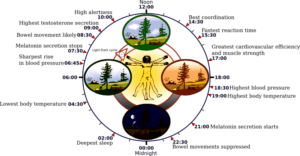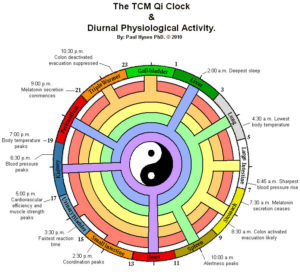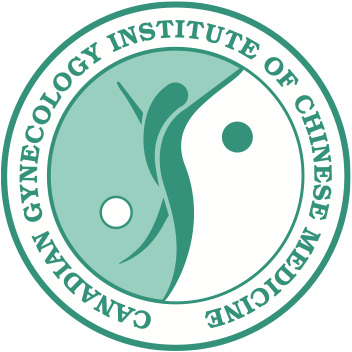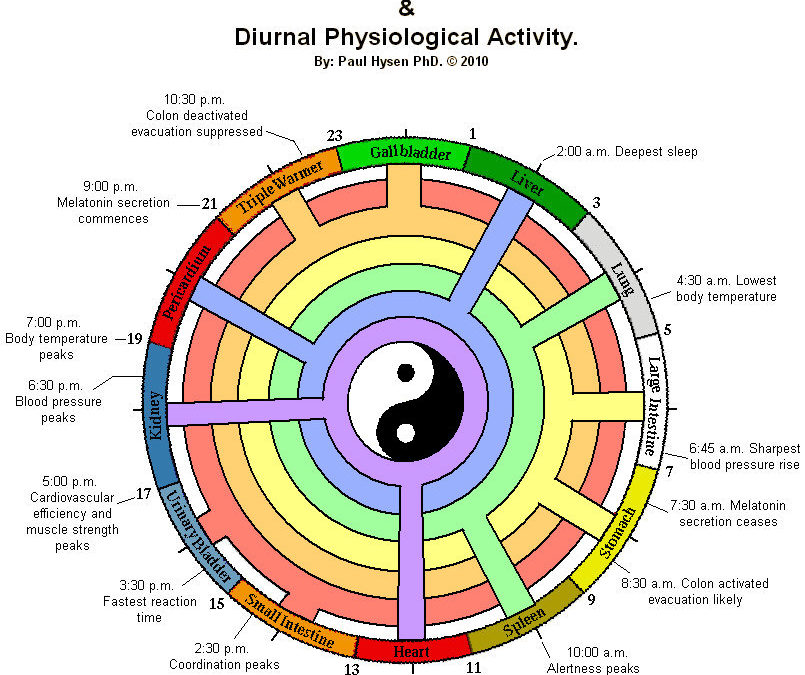What is chronobiology?? Basically, it is the study of biological rhythms. Everywhere we look there are rhythms, from the ocean’s tides and seasons, to our heartbeats and breath, we are alive because of ebb and flow – yin and yang. (all references taken from Liu Bing Quan) For example, in the
- Blood System: B-cell and T-cell counts are highest between 0:00-4:00 and lowest between 12:00-16:00; serum cAMP (an intracellular signal transducer) is highest atmidday and lowest at night.
- Circulatory System: blood pressure tends to raise throughout the day
- Respiratory System: according to experimental data, airway resistance, volume of air flow and pressure difference reach their peak at 5:00
- Digestive System: pancreatic secretions decrease during the summer. Studies based on time of food consumption show that those who eat only one meal at night will gain weight while those who eat in the morning will lose weight due to the circadian rhythmic secretion of insulin
- Temperature: body temperature is lowest between 2:00-6:00 and highest between 17:00-18:00
- Metabolism: storage of human hepatic glycogen is exhausted at 3:00-6:00
- Endocrine: blood testosterone peaks at 8:00-9:00 and is lowest at midnight; blood ACTH is higher during the day and lower at night and peaks at 8:00-9:00; glucocorticoids peak at 6:00-8:00 and trough at 21:00-1:00

What Does This Mean in Chinese Medicine?
- Kidney: wax time of Kidney Channel peaks at 17:00-19:00. Western studies show that glomular filtration rates and renal blood flow values (indicating optimal renal health and function) peak at 17:30.
- Liver & Gallbladder: wax time of Liver and Gallbladder Channel peaks at 23:00-03:00. Western studies show that peak values of bile excretion, concentration of bile salt, cholesterol, phosphatide and hepatic enzymes occurs at 23:00-0:00.
- Lung: wax time of the Lung Channel peaks at 03:00-05:00. Western studies show that airway resistance and variation of volume and pressure within the thoracic cavity peak at 05:00.
- Spleen: wax time of the Spleen Channel peaks at 09:00-11:00. Western studies show that monocytes in venous blood are most active at 11:00.

How Does this Influence Treatment?
By choosing treatment times, a clinician can improve certain effects. For example, in the Treatise on Exogenous Febrile Diseases, the 6 channel theory is described: Tai Yang disease resolves between 09:00-15:00, Yang Ming disease resolves between 15:00-21:00, Shao Yang disease resolves between 03:00-9:00, Tai Yin disease resolves between 21:00-03:00, Shao Yin diseases resolves between 11:00-05:00, and Jue Yin disease resolves between 01:00-07:00. This indicates that any external disease (Tai Yang) will show best results of treatment if treated between 09:00-15:00.
In Shen Nong’s Canon of Materia Medica there are statements that suggest that if a disease is in the blood, drugs (herbs) should be taken on an empty stomach before sunrise; if a disease is in the bone or marrow, drugs (herbs) should be taken on a full stomach and at night. Liu Yuan Su and Zhang Zi Gao postulate that emetic drugs (herbs) should be administered at daybreak. Li Gao & Luo Tian Yi suggest tonifying and raising drugs (herbs) and those that relieve the exterior through sweating should be taken before midday.
An excerpt from “Optimum Time for Acupuncture – A Collection of Traditional Chinese Chronotherapeutics”: Ancient Chinese doctors pointed out that “one should foster Yang during spring and summer, and foster Yin during autumn and winter” (Chapter 2, Familiar Conversation). It seems as if there are contradictions when we foster Yang instead of Yin in warm seasons and foster Yin instead of Yang in cold seasons. Nut a statistic analysis of 322 cases died of cerebral hemorrhage within 3 years (1977-1979) by the First Hospital of Wuhan Municipality revealed that during the end of autumn and the beginning of winter, the morbidity is obviously higher than those at any other time of the year. Cerebral hemorrhage corresponds to stroke or apoplexy in Traditional Chinese Medicine. Generally speaking, the attack is triggered by the influence of external factors on the basis of intrinsic deficiency of Liver and Kidney Yin. Thus, it is reasonable to foster and ameliorate the deficient status of Liver and Kidney Yin in autumn and winter to decrease the morbidity because cerebral hemorrhage is liable to occur in this period.
“Treating asthma and allergic rhinitis by local application of medicated plaster during the… hottest time of the year is also an implementation of this principle. Here, it is called the strategy of treating winter disease in summer. The teaching and research section of acupuncture and moxibustion in Guangdong Hospital of Traditional Chinese Medicine had reported their therapeutic results in three years. 586 cases had been followed up, effective rate attained 78%. There are also asthma patients who get their attacks in summer. As to these patients, they applied medicated plasters in the 9 day period after the winter solstice. This is called the strategy of treating a summer disease in winter.”
There is an entire treatment theory based on treating conditions based on time of day and this is just a sprinkle of the information available. Treating based on time of day is useful for treating general conditions of Yin and Yang imbalances as well as specific organ functions in Chinese Medicine and following hormonal (metabolic) peaks in Western Medicine. It is the smooth, uninterrupted and cyclical flow of Qi that ensures optimum health and longevity. If you have any questions, please contact us.
Caroline Prodoehl, BA, CDA, D.Ac, TCMP
References
Liu Bing Quan (1988). Optimum Time for Acupuncture – A Collection of Traditional Chinese Chronotherapeutics. ShandongScience and Technology Press. Yu Han Lu,Jinan,China.

